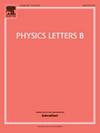f(Q,Lm)引力中的修正宇宙学
IF 4.3
2区 物理与天体物理
Q1 ASTRONOMY & ASTROPHYSICS
引用次数: 0
摘要
在这封信中,我们使用非线性模型f(Q,Lm)=−Q+α lmn +β,在修正的f(Q,Lm)引力框架内研究宇宙学,其中α, β和n是自由参数。导出了物质主导宇宙的修正弗里德曼方程,并得到了其解析解。使用哈勃、万神殿+和联合数据集,我们约束了模型参数并检查了它们的含义。结果表明,模型可以适应不同的H0值,这有助于哈勃张力,而n≠1表明偏离广义相对论(GR)。减速参数证实了在zt≈0.6−0.8处向加速度的转变,其当前值支持宇宙加速度。这个模型为基于gr的宇宙学提供了一个可行的替代方案。本文章由计算机程序翻译,如有差异,请以英文原文为准。
Modified cosmology in f(Q,Lm) gravity
In this letter, we investigate cosmology within the framework of modified gravity using the non-linear model , where α, β, and n are free parameters. The modified Friedmann equations are derived for a matter-dominated universe, and an analytical solution is obtained. Using Hubble, Pantheon+, and joint datasets, we constrain the model parameters and examine their implications. The results indicate that the model accommodates varying values, contributing to the Hubble tension, while suggests deviations from general relativity (GR). The deceleration parameter confirms a transition to acceleration at , with present values supporting cosmic acceleration. This model offers a viable alternative to GR-based cosmology.
求助全文
通过发布文献求助,成功后即可免费获取论文全文。
去求助
来源期刊

Physics Letters B
物理-物理:综合
CiteScore
9.10
自引率
6.80%
发文量
647
审稿时长
3 months
期刊介绍:
Physics Letters B ensures the rapid publication of important new results in particle physics, nuclear physics and cosmology. Specialized editors are responsible for contributions in experimental nuclear physics, theoretical nuclear physics, experimental high-energy physics, theoretical high-energy physics, and astrophysics.
 求助内容:
求助内容: 应助结果提醒方式:
应助结果提醒方式:


